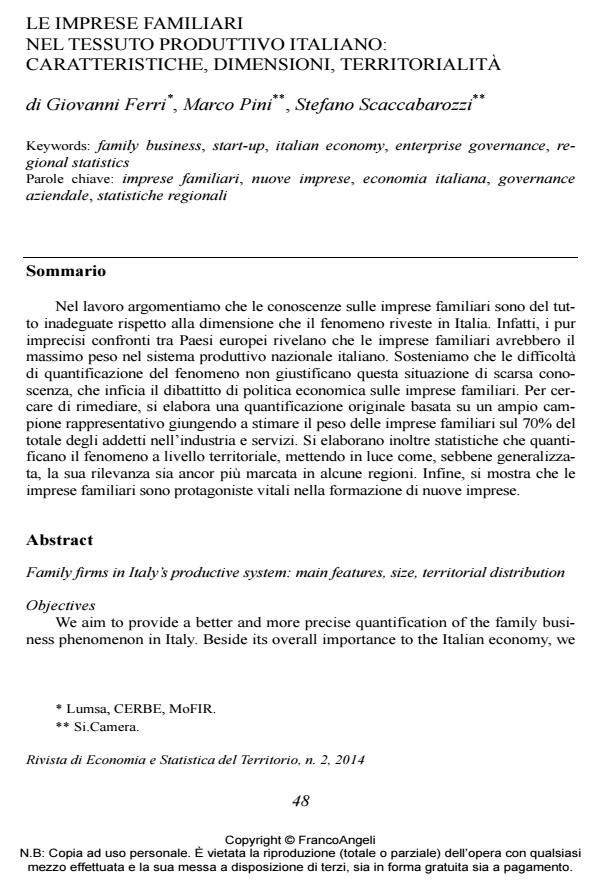Family firms in Italy’s productive system: main features, size, territorial distribution
Journal title RIVISTA DI ECONOMIA E STATISTICA DEL TERRITORIO
Author/s Giovanni Ferri, Marco Pini, Stefano Scaccabarozzi
Publishing Year 2014 Issue 2014/2
Language Italian Pages 30 P. 48-77 File size 981 KB
DOI 10.3280/REST2014-002003
DOI is like a bar code for intellectual property: to have more infomation
click here
Below, you can see the article first page
If you want to buy this article in PDF format, you can do it, following the instructions to buy download credits

FrancoAngeli is member of Publishers International Linking Association, Inc (PILA), a not-for-profit association which run the CrossRef service enabling links to and from online scholarly content.
We aim to provide a better and more precise quantification of the family business phenomenon in Italy. Beside its overall importance to the Italian economy, we also seek to offer territorial breakdowns of the family business intensity throughout the country. In this sense, the paper sets out observing that the status of the knowledge on family firms in Italy is gravely unsatisfactory, even more so in light of the quintessential role these firms play in the country’s national economy. In fact, the few available cross country comparisons uncover that family businesses would have the largest share of the national productive system exactly in Italy. The distance between the family business share estimated in Italy and elsewhere is so large to overshadow the possible differences - e.g., those due to calculations based on different methods and definitions, if not purely relying on experts’ opinions - that may make those comparisons not fully reliable. Methods and Results Our method classifies as family business any firm that is either 1) a single individual venture, or 2) a partnership of individuals, or 3) a private limited company in which beyond 50% of the voting shares is held by a single person and/or by family related persons and where, at the same time, a member of the family holds top managing/directors roles in the company or the family, altogether, holds the majority of those roles. Our original exercise consists in applying this method in a very large sample of Italian enterprises. This permits us to quantify that family firms account for some 70% of total employees in the industry and services sectors. We also calculate statistics quantifying the phenomenon on a territorial level, highlighting that, even though generalized, the relevance of family businesses is even more marked in some regions. Finally, we show that, rather than being a sunset type of firms, family businesses are vital protagonists in the formation of new enterprises. Conclusions Our main conclusion is that the difficulties to quantify this phenomenon do not justify the current situation of scant knowledge about family firms, something that, in our view, impairs the political economy debate on this crucial segment of firms. As the Latins would say "primum cognoscere, deinde philosophari" (know first, then judge), we believe ours is a contribution to help put the policy debate back on the right track.
Keywords: Family business, start-up, italian economy, enterprise governance, regional statistics
Jel codes: C8, G32, L21, M13, M14
- Family Business in Italy: a Humanistic Transition of Assets and Values from One Generation to the Next Giorgia Nigri, Riccardo Di Stefano, in Humanistic Management Journal /2021 pp.57
DOI: 10.1007/s41463-020-00085-8 - Credit rationing and the relationship between family businesses and banks in Italy Giovanni Ferri, Pierluigi Murro, Marco Pini, in Global Finance Journal 100427/2020 pp.100427
DOI: 10.1016/j.gfj.2018.04.003 - Piccole imprese e family business: evoluzione, divari territoriali, governance e competitività Marco Pini, Paolo Quirino, in RIVISTA DI ECONOMIA E STATISTICA DEL TERRITORIO 2/2016 pp.71
DOI: 10.3280/REST2016-002003
Giovanni Ferri, Marco Pini, Stefano Scaccabarozzi, Le imprese familiari nel tessuto produttivo italiano: caratteristiche, dimensioni, territorialità in "RIVISTA DI ECONOMIA E STATISTICA DEL TERRITORIO" 2/2014, pp 48-77, DOI: 10.3280/REST2014-002003